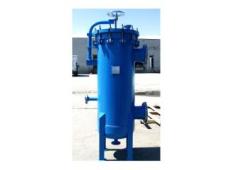Description
A vertical pressure leaf filter is a type of industrial filtration system used for separating solids from liquids. It consists of a vertical vessel with a bundle of vertically mounted filter leaves inside. These filter leaves are usually made of metal or synthetic material and are covered with filter media, such as cloth or mesh.
Here's how a vertical pressure leaf filter typically works:
Feed Introduction: The liquid containing suspended solids is introduced into the filter vessel.
Filtration: The liquid passes through the filter media on the surface of the filter leaves. The suspended solids are trapped on the surface of the filter media, forming a layer known as the filter cake.
Cake Formation: As the filtration process continues, the filter cake builds up on the surface of the filter leaves. This cake layer helps to improve the filtration efficiency by capturing finer particles.
Cake Removal: Periodically, when the filter cake reaches a certain thickness or when the filtration efficiency decreases, the filtration process is halted, and the filter cake is removed. This can be done by various methods such as scraping, blowing, or washing the cake off the filter leaves.
Liquid Discharge: The filtered liquid, now free from suspended solids, exits the filter vessel and is collected for further processing or disposal.
Vertical pressure leaf filters are commonly used in industries such as oil and gas, chemical processing, pharmaceuticals, and food and beverage production, where high-efficiency filtration of liquids is required. They offer advantages such as high filtration rates, efficient cake removal, and the ability to handle a wide range of particle sizes and concentrations.
- VERTICAL PRESSURE LEAF FILTER
- HORIZONTAL PRESSURE LEAF FILTER
- MOLTEN SULPHUR FILTER
- FILTER ELEMENTS
- PULSE JET CANDLE FILTER
- POLISHING AND BAG FILTER
- SELF CLEANING FILTERS & STRAINERS
- OIL FIELD FILTRATION EQUIPMENTS
- BASKET FILTERS & STRAINERS
- PROCESS FILTRATION & EQUIPMENTS
- 'Y', 'T' TYPE AND CONICAL STRAINERS
- AUTO BACKWASH FILTER













